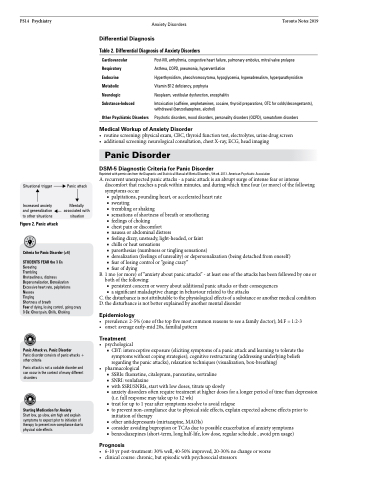Page 1178 - TNFlipTest
P. 1178
PS14 Psychiatry
Anxiety Disorders Toronto Notes 2019 Differential Diagnosis
Table 2. Differential Diagnosis of Anxiety Disorders
Cardiovascular Respiratory Endocrine Metabolic Neurologic Substance-Induced
Other Psychiatric Disorders
Post-MI, arrhythmia, congestive heart failure, pulmonary embolus, mitral valve prolapse Asthma, COPD, pneumonia, hyperventilation
Hyperthyroidism, pheochromocytoma, hypoglycemia, hyperadrenalism, hyperparathyroidism Vitamin B12 deficiency, porphyria
Neoplasm, vestibular dysfunction, encephalitis
Intoxication (caffeine, amphetamines, cocaine, thyroid preparations, OTC for colds/decongestants), withdrawal (benzodiazepines, alcohol)
Psychotic disorders, mood disorders, personality disorders (OCPD), somatoform disorders
Situational trigger
Increased anxiety and generalization to other situations
Figure 2. Panic attack
Panic attack
Mentally associated with situation
Medical Workup of Anxiety Disorder
• routinescreening:physicalexam,CBC,thyroidfunctiontest,electrolytes,urinedrugscreen • additionalscreening:neurologicalconsultation,chestX-ray,ECG,headimaging
Panic Disorder
DSM-5 Diagnostic Criteria for Panic Disorder
Reprinted with permission from the Diagnostic and Statistical Manual of Mental Disorders, 5th ed. 2013. American Psychiatric Association
A. recurrent unexpected panic attacks - a panic attack is an abrupt surge of intense fear or intense discomfort that reaches a peak within minutes, and during which time four (or more) of the following symptoms occur
■ palpitations, pounding heart, or accelerated heart rate ■ sweating
■ trembling or shaking
■ sensations of shortness of breath or smothering
■ feelings of choking
■ chest pain or discomfort
■ nausea or abdominal distress
■ feeling dizzy, unsteady, light-headed, or faint
■ chills or heat sensations
■ paresthesias (numbness or tingling sensations)
■ derealization (feelings of unreality) or depersonalization (being detached from oneself) ■ fear of losing control or “going crazy”
■ fear of dying
B. 1 mo (or more) of “anxiety about panic attacks” - at least one of the attacks has been followed by one or both of the following:
■ persistent concern or worry about additional panic attacks or their consequences
■ a significant maladaptive change in behaviour related to the attacks
C. the disturbance is not attributable to the physiological effects of a substance or another medical condition
D. the disturbance is not better explained by another mental disorder
Epidemiology
• prevalence: 2-5% (one of the top five most common reasons to see a family doctor); M:F = 1:2-3 • onset: average early-mid 20s, familial pattern
Treatment
• psychological
■ CBT: interoceptive exposure (eliciting symptoms of a panic attack and learning to tolerate the
symptoms without coping strategies); cognitive restructuring (addressing underlying beliefs
regarding the panic attacks), relaxation techniques (visualization, box-breathing) • pharmacological
■ SSRIs: fluoxetine, citalopram, paroxetine, sertraline
■ SNRI: venlafaxine
■ with SSRI/SNRIs, start with low doses, titrate up slowly
■ anxiety disorders often require treatment at higher doses for a longer period of time than depression
(i.e. full response may take up to 12 wk)
■ treat for up to 1 year after symptoms resolve to avoid relapse
■ to prevent non-compliance due to physical side effects, explain expected adverse effects prior to
initiation of therapy
■ other antidepressants (mirtazapine, MAOIs)
■ consider avoiding bupropion or TCAs due to possible exacerbation of anxiety symptoms ■ benzodiazepines (short-term, long half-life, low dose, regular schedule , avoid prn usage)
Prognosis
• 6-10 yr post-treatment: 30% well, 40-50% improved, 20-30% no change or worse • clinical course: chronic, but episodic with psychosocial stressors
Criteria for Panic Disorder (≥4)
STUDENTS FEAR the 3 Cs Sweating
Trembling
Unsteadiness, dizziness Depersonalization, Derealization Excessive heart rate, palpitations Nausea
Tingling
Shortness of breath
Fear of dying, losing control, going crazy 3 Cs: Chest pain, Chills, Choking
Panic Attack vs. Panic Disorder
Panic disorder consists of panic attacks + other criteria
Panic attack is not a codable disorder and can occur in the context of many different
disorders
Starting Medication for Anxiety
Start low, go slow, aim high and explain symptoms to expect prior to initiation of therapy to prevent non-compliance due to physical side effects


